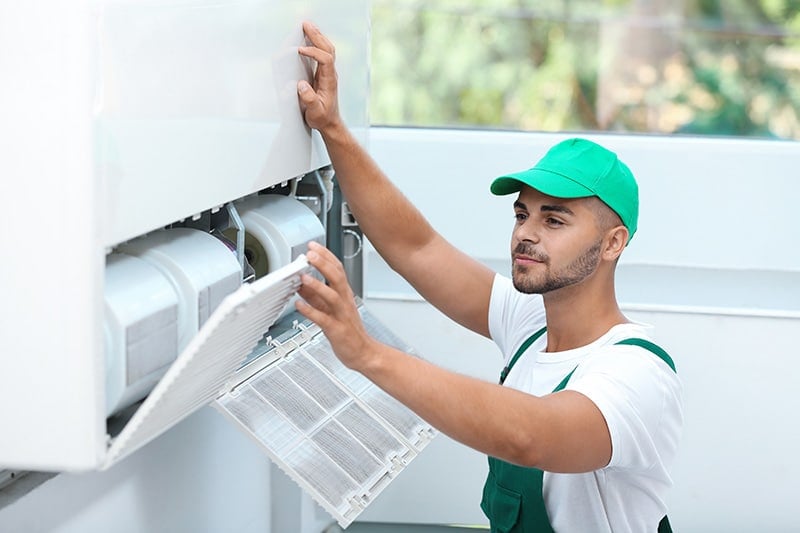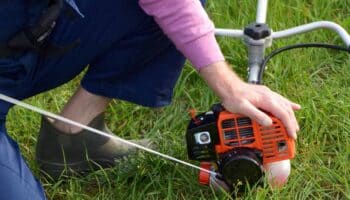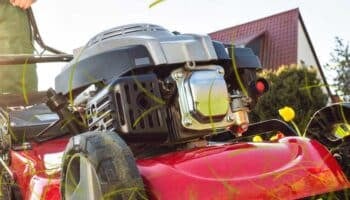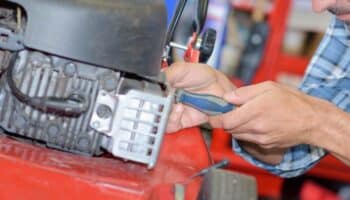Is your lawn mower’s battery dead? Are you wondering if you can jump-start it with your car?
Let’s assume you have a riding mower and the battering you’re talking about is for it and not a battery-powered push mower or an electric-start gas-powered push mower. More on those in a few moments.
The reason to focus on a riding mower, more than anything, is because it is, essentially, an automobile built for mowing. It’s also built with a small internal combustion engine that requires a battery to start.
If you have a car with a dead battery, there’s always an option to jump start the car using the power of another car until you can either replace or recharge the battery. The same goes for a lawn mower.
Now, let’s get into the business of jump-starting a lawn mower using a car in six easy steps.
1. Safety
Yes, safety always comes first. Not only because you’re dealing with electricity but also because you’re dealing with the power of a car. It’s one thing to deal with a lawn mower. Now you’re dealing with a lawn mower and a car.
So, yes, time to cover some safety precautions. This also means you should have not only your mower’s manufacturer’s manual with you but also the owner’s manual for the car you’re going to use as references. More than likely, both will have procedures in them on how to set up connections to jump start vehicles.
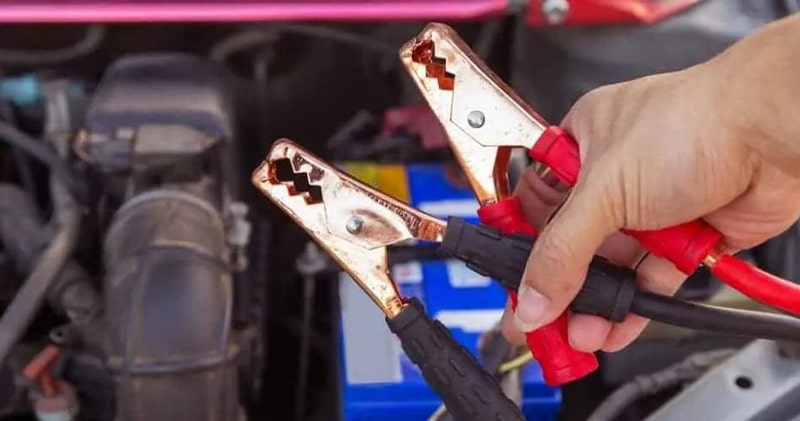
Another thing to take into account is the weather. If the weather is poor and you don’t have a garage or something like a carport, you may want to hold off on doing this until the climate is better suited for this type of procedure.
From there, have a good set of jumper cables ready. They should be clean of any kind of grime on the clamps. The clamps should be undamaged, as should the cables. Also, have ready a wire brush and cleaning gear if dirt and grime are present on the clamps or on the battery terminals. You want to clean those before starting the mower.
2. Battery-Operated Mower and Electric-Start Gas Mower
If you have a battery-operated push mower, you shouldn’t be considering a jump start as an alternative. Again, don’t attempt to jump or charge your electric mower’s battery with a car. That’s why a battery charger came with it.
Put the battery on the charger. If it doesn’t charge, buy a new battery.
If you want to get any replacement part – or see how much one would cost – click to enter your model number in the search bar below. Our partners at AppliancePartsPros stock almost every part with free guides on how to install them.

If you have a gas-powered mower with an electric start, your mower should also have a traditional pull-cord starter as a backup. There are ways to jump start this type of mower, as well, using a battery jump pack. You don’t want to try doing it with a car though. And again, a battery charger should have come with the mower.
Okay, back to jump-starting a riding mower.
3. Ensure the Mower Battery is Dead
This may sound like an odd step but to be sure, double-check that the mower battery is truly dead. This can be done by simply trying to start the mower.
If it sounds like the engine is trying to start in slow motion, the battery is officially almost dead in that it doesn’t have enough of a charge to turn the engine completely over to start.
If it sounds like the engine is doing nothing at all and all you hear is a click, then the battery is completely dead.
4. Positioning the Mower and Car
Just like jump-starting a car, you want to make sure the car you’re using to jump-start the mower and the mower itself are as close together as possible. Not so close that they’re touching but close enough that the cables can connect to both batteries with enough slack.
Also, you want enough room to move around the car and mower. The best position is one where the cables aren’t stretched too much and you don’t have to lean too far over anything to attach the clamps, etc.
Again, if the weather is bad, try to do this procedure under a covering. If you don’t have anything but the open air, wait for the weather to improve.
5. Making the Connections
Now that you’ve reviewed the owner’s manuals and safety tips, and positioned the car safely close to the mower, it’s time to make the connections to officially jump-start your mower carefully.
- Make sure your mower’s battery is a 12V battery. If it’s less, stop now. You shouldn’t attempt to jump a battery with a car if it’s lower than 12V.
- Once again, make sure the battery terminals on both the mower and the car are clean.
- Ensure both the mower and car are off and the keys are removed from the ignitions.
- Taking a normal pair of undamaged and clean jumper cables, connect the positive clamp to the positive terminal on the car battery.
- Connect the other positive end of the jumper cable to the positive end of the mower battery.
- Connect the negative end of the cable to the negative terminal on the car battery.
- Connect the other negative end of the cable to a metal part of the frame of the mower, not the negative terminal on the mower battery. This creates a ground when you jump start the mower.
When it comes time to remove the cable attachments, simply do it in the reverse order that you did setting them up.
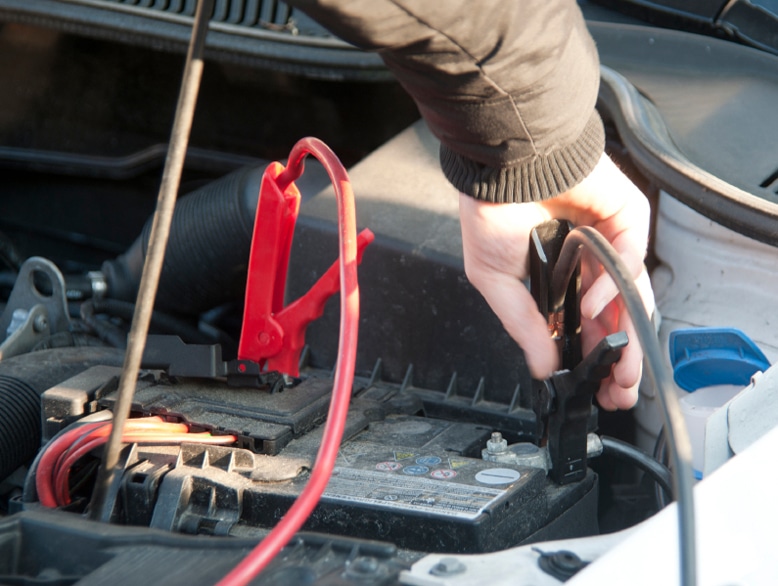
Also, when your positive ends are connected, make sure the positive end on the mower side doesn’t come in contact with any other metal on the mower while making the connection or you risk electrical shock.
6. Starting and Running Your Mower
Once the connections are all made, let everything sit for a few moments before starting the car. Once you start the car, let it run a bit before moving on to the mower.
After a few minutes are up, go ahead and turn the ignition over and see if the mower starts. If it doesn’t, let the battery charge some more. If it does start, let it run. The mower’s generator will take overcharging the dead battery.
While it’s running, go ahead and disconnect the cables in reverse order from how you hooked them up. As for how long to run the mower, it won’t hurt to let it go for about fifteen to thirty minutes.
If the battery fails to charge, you may have to replace it completely. If that isn’t the issue and you hear nothing but rapid clicking noises, it may not be a battery issue. Instead, it may be a starter solenoid problem.
Lastly, if you attempt to jump the battery too many times, you’re more than likely wasting time. Replace the battery at this point.
If new batteries don’t help, it may be time to get your mower inspected and serviced by a technician.
Of course, if the mower is old and the repair cost starts to look too high, you may want to consider looking around for good deals on new or lightly used models to take its spot. This is especially true if you have major repairs needed throughout the electrical system.
Conclusion
Like dealing with a car battery, a dead mower battery can be annoying but, in the long run, is one of those things you know will have to be charged and eventually replaced. The good news is that if a battery dies before it’s reached the end of its service life, there are ways to get it back up and running and recharged without having to completely replace it yet.
Yet.
Keep that in the back of your mind. Yes, you can jump start a mower with a dead battery. However, eventually, even jump-starting will no longer be a viable option and that battery will have to be replaced.


